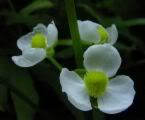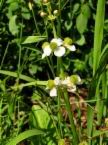

Scientific Name
Sagittaria latifolia
Uses of Broadleaf Arrowhead: Landscaping, Medicinal, Culinary, etc...
This is a multipurpose emergent plant, however the greatest value this species offers is as food and cover for aquatic animal life. The seed and tubers of duck potato are readily consumed by waterfowl, songbirds, wading birds, muskrats, and beaver. The emergent foliage of this species provides cover to the same animals with the addition of fish and aquatic insects. During the growing season notable amounts of nutrients and metals are extracted by Sagittaria latifolia from sediments and water. Turbidity and wave energy is reduced by adequately stocked and healthy stands.
General Characteristics
Duck potato is a highly rhizomatous perennial broadleaf emergent capable of attaining heights of 4 feet. The terminal hastate or sagittate leaves are 4 to 12 inches long and acute. Each leaf lobe has an equally distinct vein radiating to it from the leaf base. Vegetative production peaks in July, but by mid fall the emergent plant parts annually die back to the root crown. Prior to the annual die back, nutrients and carbohydrates are translocated to subterranean tubers (root storage organs).
Duck potato exhibits both dioecious and moenecious reproductive character in its northern and southern ranges respectfully. Between July and September one or two tapering cylindrical flowering stalks (scapes) emerge holding 2 to 15 whorls of white, three petaled flowers with yellow reproductive parts. Each stalk is taller than the leaves. From August to October round clusters of seed (achenes) develop; with yields up to 20,000 viable achenes produced per plant. Each achene contains a flattened ovate green nutlet.
Required Growing Conditions
Duck potato has a native range which extends from New Brunswick to British Columbia, south to Florida, California and Mexico. This broadleaf emergent thrives in finely textured unconsolidated organic and silty wet soils. Such conditions are typically found in marshes, swamps, forested seeps, ditches, and in the shallows of streams, lakes and ponds. Duck potato thrives in fresh water 6 to 12 inches deep, full sun exposure, with pH ranging from 6.0 to 6.5, but is tolerant of less adequate conditions.
Cultivation and Care
Duck potato can be successfully established vegetatively, with tubers, bare-root or potted stock. As a general rule tubers should be placed on sites with less than one foot of permanent inundation, while the leaves of transplants should never be submerged. For large plantings tubers are most efficiently used, but on critical sites the use of bare-rooted and potted stock is more reliable. A single plant can annually yield up to 40 tubers, with each tuber capable of vegetatively producing 3 to 5 planting units. Site quality will dictate plant spacing. Under ideal site conditions plants can be spread up to 6 feet apart and still attain stand closure within one growing season. On degraded or critical sites it is advisable to reduce plant spacing to 1 to 2 feet. Utilizing seed in greenhouse and nursery production is reliable and highly recommended to maintain genetic diversity. Field seeding techniques have not been refined to attain predictable results. The achenes are easily harvested, cleaned, and broadcast sown. Prior to spring sowing, the seeds need a three month moist stratification treatment. Sow on to well worked, saturated soils. Germination occurs under direct sunlight with temperatures ranging from 80° to 90° F.
General Upkeep and Control
Stand growth and health is sustained on fertile unconsolidated soils, with adequate hydric regimes (6-12 in.). Winter draw-down periods are necessary to encourage voluntary reseeding; otherwise tubers will be relied on for re-growth. Nutrient rich water sources or applications of commercial fertilizers stimulate additional bio-mass production. The gradual acclimation to a particular effluent is necessary to utilize the plant’s maximum pollution extraction potential.
Cultivars, Improved, and Selected Materials (and area of origin) No known varieties are available, but wetland plant nurseries carry local or regional ecotypes.





0 comments: